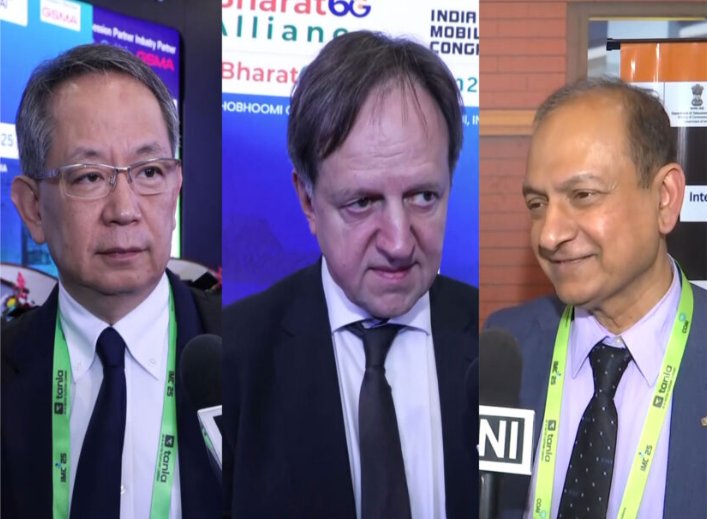Professor Harald Haas Sees Transformative Potential For LiFi Technology and Optical Wireless Technology in Bridging India's Connectivity Divide
Credit to India Mobile Congress 2025
INDIA MOBILE CONGRESS — As India accelerates its push toward universal digital connectivity, a pioneering technology that transmits data through light waves rather than radio frequencies is emerging as a potential game-changer. Professor Harald Haas, Director of the TITAN research centre and “Father of Light Fidelity (LiFi)” technology, believes India is uniquely positioned to lead the global adoption of this next-generation communications solution.
Speaking at the India Mobile Congress this week, where he is representing the UK's future telecoms research landscape, Professor Haas outlined an ambitious vision for how optical wireless communications could address India's most pressing connectivity challenges while positioning the nation as a technology developer rather than merely a consumer.
A Dual-Purpose Solution
Professor Haas describes LiFi's potential in India as multifaceted, capable of addressing both urban capacity demands and rural connectivity gaps simultaneously. "LiFi can be applied and deployed indoors, so you can build really high-speed indoor connectivity, but you also can build free space optical communications to connect the unconnected, connect the rural communities," he explained.
This versatility is particularly relevant for India, where dense urban centres strain existing network capacity while vast rural regions remain inadequately served by traditional infrastructure. The technology uses light waves, from LEDs, infrared, or ultraviolet sources, to transmit data at extremely high speeds, creating what Haas calls "a nervous system" of fully connected communications.
Complementing, Not Competing
Rather than positioning LiFi as a replacement for existing cellular networks, Professor Haas emphasises its role as a complementary technology that can enhance India's 5G infrastructure and future 6G deployments. "It can complement current 5G networks and 6G networks by providing additional capacity, by providing data capacity where, in regions there that are not connected yet, and where you can't put in a fibre because it's too expensive," he noted.
The economic argument is particularly compelling for rural India, where the cost of laying fibre optic cables often makes connectivity projects financially unviable. Free space optical links can establish long-distance connections without the infrastructure expenses of traditional wired solutions, creating strong backhaul and fronthaul networks that support local radio communications technologies.
The technology also extends beyond terrestrial applications. Professor Haas highlighted the potential for "building very strong optical wireless links to satellites for non-terrestrial network connectivity," opening possibilities for seamless integration between ground-based and space-based communication systems.
India's Opportunity to Lead
Professor Haas expressed admiration for India's mobile technology adoption, noting that "everybody uses mobile phones and data connectivity is so important here." But he sees an opportunity for India to move beyond consumption to become a technology developer and supplier.
"India can develop a lot by adopting further technology, but also developing the technology for connectivity," he said, suggesting that the nation's engineering talent and manufacturing capabilities could position it as a global hub for optical wireless communications equipment and solutions.
Sustainable Connectivity
In a nation investing heavily in solar energy, Professor Haas outlined an intriguing synergy between LiFi technology and renewable power. "We have used LiFi technology in conjunction with solar cells. Solar cells are powering our grids at a moment, but we can also see a pathway where a solar panel is also broadband receiver," he explained.
This dual-purpose approach, where solar panels simultaneously harvest energy and receive data, could dramatically reduce the infrastructure footprint and operating costs of rural connectivity projects. The technology aligns with India's ambitious renewable energy targets while addressing digital inclusion goals.
Additionally, LiFi's inherently large bandwidth enables more energy-efficient modulation techniques. "We can use modulation techniques that are more energy efficient by harnessing the large bandwidth, making the entire sort of connectivity more energy efficient," Professor Haas noted, a crucial consideration as India works to expand digital access while managing energy consumption.
Looking Ahead
As India charts its course toward becoming a digitally empowered society and knowledge economy, Professor Haas's vision presents a compelling alternative to the assumption that tomorrow's connectivity will simply be an incremental upgrade of today's technologies. Optical wireless communications offer a pathway to leapfrog traditional infrastructure limitations while building sustainable, high-capacity networks suited to India's unique geography and development challenges.
Whether India seizes this opportunity to become not just an adopter but a developer and exporter of LiFi technology may well determine its position in the global telecommunications landscape of the coming decades.


